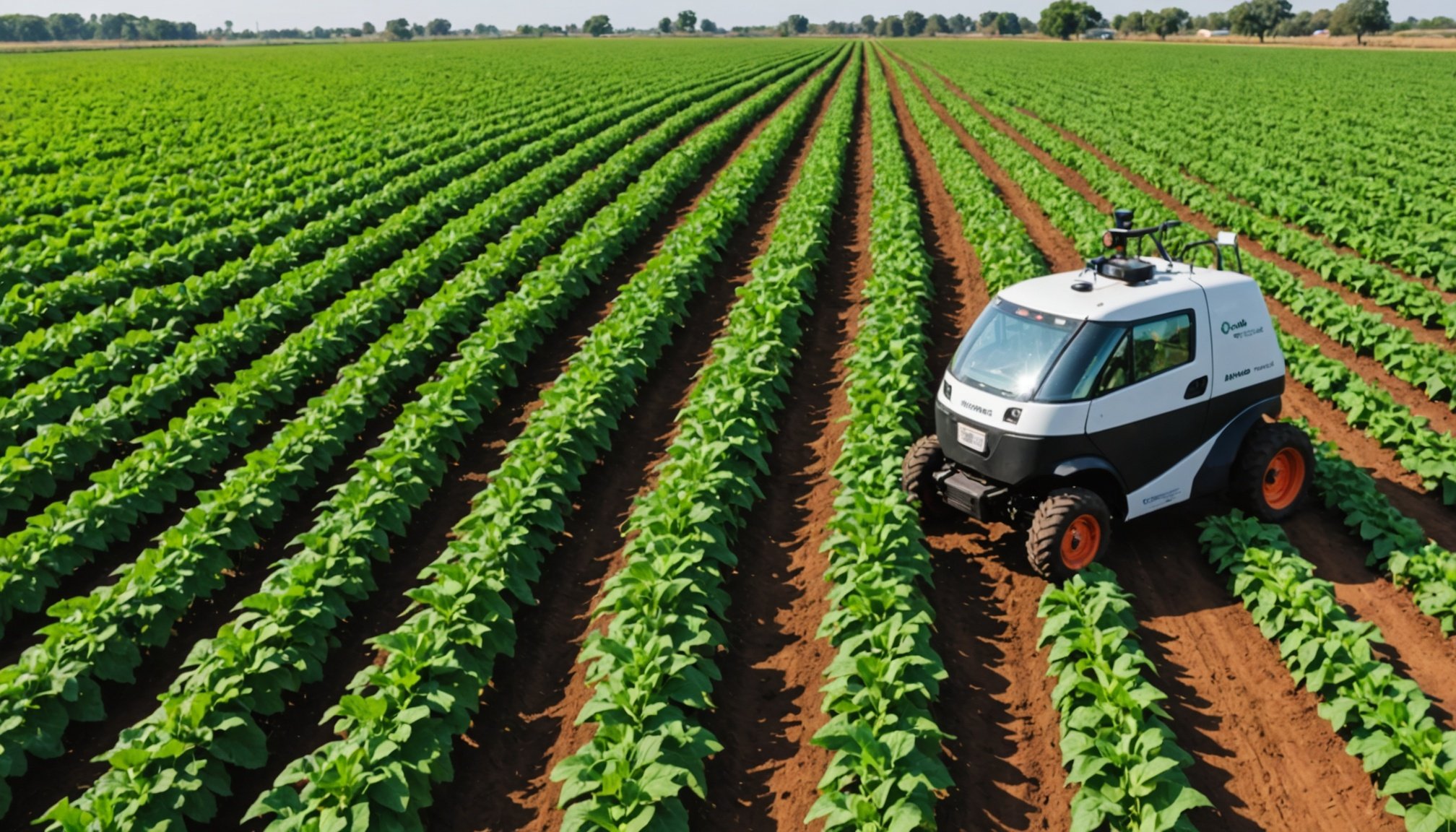Introduction to AI and IoT in Pest Management
Modern agriculture is undergoing a transformation, with AI in agriculture and IoT applications revolutionising pest management technologies. The integration of these advanced technologies is significant as it allows farmers to optimise their resource use and improve crop health.
AI in agriculture enables enhanced decision-making through data-driven insights. Machine learning algorithms analyse vast datasets to predict potential pest threats and recommend effective interventions. This capability ensures timely and precise actions, minimising crop loss. Meanwhile, IoT applications involve deploying smart devices like sensors that continuously monitor environmental conditions, detecting pests in real-time. This data is invaluable in crafting proactive pest management strategies.
Also to read : Unlocking potential: how uk tech firms propel innovation by teaming up with universities
Current trends in pest management innovations are marked by cutting-edge technologies aiming to increase efficiency and reduce the environmental footprint. These trends include the development of sophisticated pest detection systems and autonomous monitoring tools, which significantly lessen the reliance on chemical pesticides. Moreover, the synergy between AI and IoT applications not only enhances the precision of pest control measures but also fosters a sustainable agricultural ecosystem by reducing the environmental impact.
Benefits of AI and IoT in Pest Management
The synergy between AI in agriculture and IoT applications is pivotal in driving efficiency in agriculture. Through data analysis, AI tools facilitate enhanced decision-making, allowing farmers to predict pest infestations with remarkable accuracy. This data-driven approach not only optimises interventions but also contributes significantly to cost savings by reducing unnecessary pesticide applications.
In parallel : Transforming event management: how machine learning enhances real-time crowd control at large gatherings
By prioritising targeted pest control, these technologies substantially lower pesticide usage, thereby minimizing environmental impact. This proactive approach leads to healthier ecosystems and supports sustainable farming practices. The real-time monitoring capabilities of IoT devices ensure any potential threats are addressed promptly, safeguarding crops from damage.
Furthermore, the integration of AI and IoT in pest management leads to improved crop yields. By ensuring optimal pest control, crops are less stressed, and resources like water and nutrients are utilised more efficiently. Ultimately, this results in heightened productivity and profitability for farmers. Embracing these advanced technologies facilitates a modern and resilient agricultural landscape, equipped to meet the challenges of today and the future. With ongoing advancements, efficiency in agriculture continues to be elevated, offering promising avenues for sustainable growth.
Technologies and Tools in AI and IoT for Pest Management
The integration of smart farming tools and pest detection technologies in agriculture is reshaping how farmers approach pest management. These innovations facilitate precise interventions, thereby enhancing efficiency.
AI-powered Predictive Analytics
Machine learning applications leverage historical data to forecast pest occurrences, allowing farmers to implement preemptive measures. By predicting pest trends, these tools ensure timely actions and reduce crop loss.
IoT Sensors and Monitoring Systems
IoT sensors provide continuous real-time monitoring of environmental conditions, crucial for early pest detection. These systems alert farmers almost instantaneously when pest levels breach a certain threshold, ensuring rapid response.
Automated Pest Detection Devices
Automation in pest management is vital for scalability and consistency. Automated devices utilise AI to identify pests, eliminating the need for manual inspections. This not only saves time but enhances accuracy in pest identification.
These technologies together form the backbone of modern pest management technologies, offering a multifaceted solution to tackle pest issues efficiently. As these smart farming tools become more prevalent, they promise to lead pest control into a more sustainable and technologically advanced future.
Real-world Case Studies
The integration of AI and IoT has redefined pest management in agriculture, as demonstrated by various success stories. One notable case involves a rice farm in Vietnam that utilized AI-driven predictive analytics combined with IoT sensor data to combat pest infestations efficiently. This approach reduced pesticide use by 30%, showcasing considerable pest management results.
Agricultural case studies also highlight the significance of these technologies. In Spain, vineyards employ IoT devices to monitor humidity and temperature, crucial factors in predicting pest activity. The data analytics help forecast potential threats, boosting vine health and wine yield. This instance underscores the precision and effectiveness of data-driven interventions.
Lessons learned from such success stories emphasize the importance of real-time data and proactive management. Farmers have noted the shift from reactive to preventive measures, significantly lowering crop damage risks. The results underline the value of adopting AI and IoT for data-backed decision-making in agriculture. These case studies reveal that careful implementation of these technologies can lead to transformative benefits in pest management, driving efficiency and profitability.
Expert Insights and Future Trends
The landscape of agricultural technology is being reshaped by continuous pest management innovations. Insights from agritech specialists reveal the transformative potential of AI and IoT in this field, underscoring a future rich with possibilities.
Perspectives from Agricultural Experts
Leading experts emphasize the necessity of integrating these technologies to enhance efficiency and precision in pest control. They note that these tools allow for more nuanced interventions that align with environmental conservation goals, fostering sustainable agriculture.
Innovations on the Horizon
Upcoming innovations focus on enhancing AI’s predictive capabilities and IoT’s real-time data acquisition. Advances such as blockchain for data integrity and augmented reality for visual pest identification are set to redefine the boundaries of traditional pest management.
Challenges and Considerations
While promising, the adoption of these technologies presents hurdles. Experts highlight technology adoption barriers, such as cost and the need for farmer education. They call for more support in integrating these pest management innovations to ensure widespread benefits. Strategic planning and investment in infrastructure are identified as key to overcoming these challenges, paving the way for a technologically enhanced agricultural landscape.
Conclusion: The Path Forward
The journey toward sustainable agriculture hinges on the conscious integration of technology adoption. Emphasizing sustainable practices in pest management not only safeguards the environment but also boosts agricultural productivity. Farmers are encouraged to embrace modern technologies such as AI and IoT, which are instrumental in navigating the complexities of contemporary farming. These innovations streamline processes, enhance efficiency, and foster environmentally friendly practices by minimising chemical dependencies.
The role of ongoing research and development cannot be understated in this transformation. Continuous advancements ensure that pest management tools evolve, incorporating the latest insights to address emerging challenges. By prioritising thorough R&D, the agricultural sector can develop adaptable solutions tailored to diverse farming landscapes.
To facilitate future integration of technology, efforts must be directed towards educating and supporting farmers in their adaptation processes. Collaborative initiatives between agritech companies, governments, and agricultural communities are vital. These alliances promote knowledge exchange, infrastructure development, and financial assistance, paving the way for a technologically driven agricultural future. By staying committed to sustainable and innovative practices, the industry will be better equipped to meet the demands of a growing global population.







